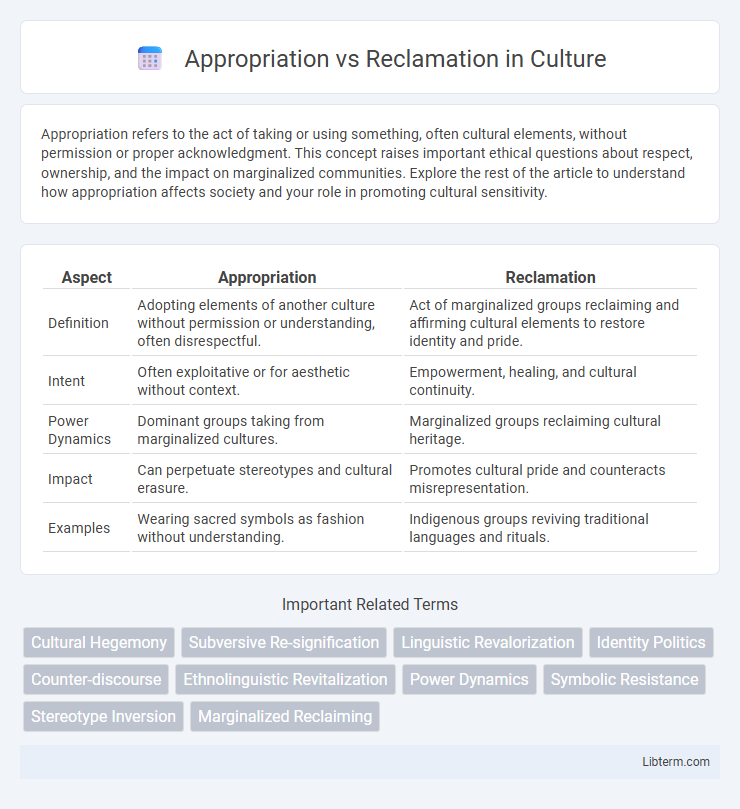Appropriation refers to the act of taking or using something, often cultural elements, without permission or proper acknowledgment. This concept raises important ethical questions about respect, ownership, and the impact on marginalized communities. Explore the rest of the article to understand how appropriation affects society and your role in promoting cultural sensitivity.
Table of Comparison
| Aspect | Appropriation | Reclamation |
|---|---|---|
| Definition | Adopting elements of another culture without permission or understanding, often disrespectful. | Act of marginalized groups reclaiming and affirming cultural elements to restore identity and pride. |
| Intent | Often exploitative or for aesthetic without context. | Empowerment, healing, and cultural continuity. |
| Power Dynamics | Dominant groups taking from marginalized cultures. | Marginalized groups reclaiming cultural heritage. |
| Impact | Can perpetuate stereotypes and cultural erasure. | Promotes cultural pride and counteracts misrepresentation. |
| Examples | Wearing sacred symbols as fashion without understanding. | Indigenous groups reviving traditional languages and rituals. |
Understanding Cultural Appropriation: Definition and Examples
Cultural appropriation occurs when elements of a marginalized culture are adopted by members of a dominant culture without proper understanding, respect, or permission, often leading to misrepresentation and harm. Examples include wearing sacred Indigenous symbols as fashion accessories or using traditional African hairstyles without acknowledging their cultural significance. Distinguishing appropriation from reclamation involves recognizing reclamation as the process where marginalized communities reclaim and celebrate their cultural practices to restore identity and pride.
What Is Reclamation? Origins and Purpose
Reclamation involves marginalized communities reclaiming symbols, language, or cultural elements previously used to oppress them, transforming these elements into expressions of identity and empowerment. Its origins trace back to social movements where oppressed groups sought to subvert negative stereotypes and assert autonomy over their cultural narratives. The purpose of reclamation is to dismantle stigma, foster pride within the community, and shift societal perceptions by redefining historically derogatory terms or practices.
Key Differences Between Appropriation and Reclamation
Appropriation involves the unauthorized use or adoption of cultural symbols, practices, or artifacts by a dominant group, often leading to misrepresentation and disrespect. Reclamation is the intentional process by which marginalized communities reclaim and restore cultural elements to affirm identity and heritage. Key differences lie in consent, power dynamics, and purpose: appropriation exploits, while reclamation empowers and heals cultural narratives.
Historical Context: Power Dynamics and Cultural Exchange
Appropriation and reclamation stem from complex historical contexts marked by power dynamics and cultural exchanges between dominant and marginalized groups. Cultural appropriation often involves the dominant culture adopting elements from a marginalized culture without proper understanding or respect, leading to exploitation and misrepresentation. Reclamation, conversely, is the process by which marginalized communities reclaim symbols, language, or practices to assert identity and resist historical oppression.
Real-World Cases of Appropriation vs Reclamation
The real-world cases of appropriation versus reclamation highlight distinct cultural dynamics, such as the use of Indigenous symbols by fashion brands criticized as appropriation, while Native communities reclaim these symbols to affirm identity and sovereignty. The "N-word" illustrates reclamation where African Americans have transformed a historically derogatory term into an expression of cultural pride, contrasting its offensive use by outsiders. Appropriation often involves power imbalances and exploitation, whereas reclamation empowers marginalized groups by restoring meaning and control over cultural elements.
The Impact on Marginalized Communities
Appropriation often involves dominant groups exploiting marginalized communities' cultural symbols without permission or respect, leading to erasure and commodification of their identities. Reclamation empowers these communities to restore meaning and pride in their heritage, fostering resilience and cultural continuity. The impact on marginalized groups includes a renewed sense of identity and resistance against systemic oppression through reclaiming narratives and symbols.
Language, Symbols, and Identity: Appropriation or Reclamation?
Appropriation involves adopting language, symbols, or cultural elements without permission, often stripping them of original meaning and reinforcing power imbalances. Reclamation occurs when marginalized groups intentionally revive and redefine these elements to assert identity, resist oppression, and restore cultural significance. Examining language and symbols through this lens highlights their role in shaping collective identity and the dynamics of cultural power.
Navigating the Gray Area: Controversies and Debates
Appropriation and reclamation both involve the use of cultural symbols, but appropriation often sparks controversy by removing context and exploiting marginalized groups, while reclamation empowers those groups to redefine and embrace these symbols. The gray area emerges when intent, power dynamics, and historical context blur the lines, leading to heated debates about respect, identity, and authenticity. Navigating these complexities requires nuanced understanding of cultural sensitivity, the source community's perspective, and ongoing dialogue to address misuse without stifacing cultural expression.
Ethical Considerations and Best Practices
Appropriation involves adopting elements of a culture without permission, often leading to misrepresentation and harm, while reclamation is the intentional recovery and empowerment of marginalized groups reclaiming symbols or practices. Ethical considerations emphasize respect, consent, and context, ensuring cultural expressions are represented authentically and without exploitation. Best practices include engaging with community members, prioritizing cultural understanding, and promoting education to foster genuine appreciation rather than superficial use.
Moving Forward: Promoting Respectful Cultural Engagement
Moving forward, promoting respectful cultural engagement requires prioritizing authentic collaboration with Indigenous communities to support reclamation efforts that restore cultural heritage and identity. Emphasizing education about the distinction between cultural appropriation and reclamation fosters understanding and respect for traditional practices. Policies and initiatives should empower marginalized groups to lead narratives and safeguard their cultural expressions from exploitation.
Appropriation Infographic

 libterm.com
libterm.com